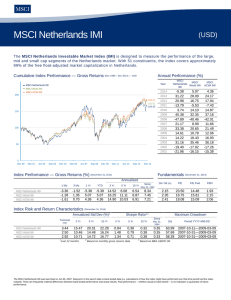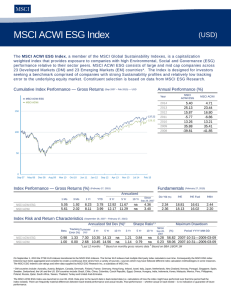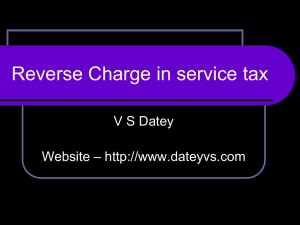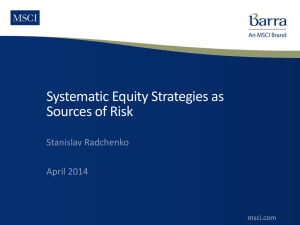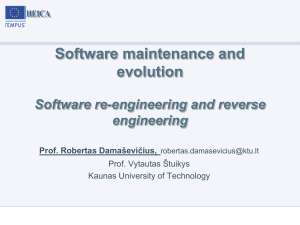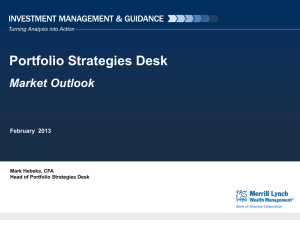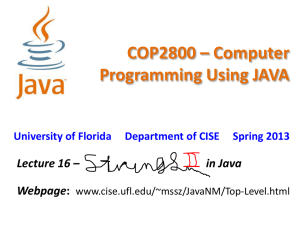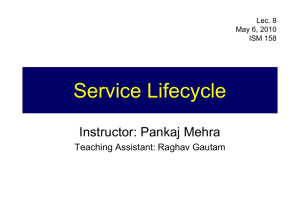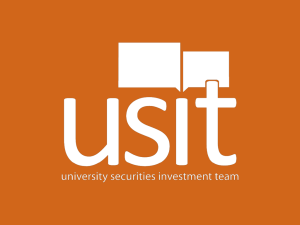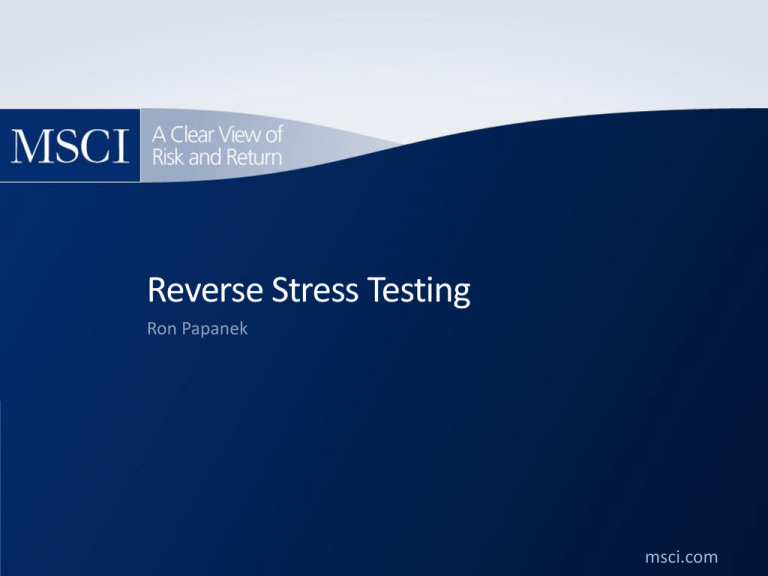
Reverse Stress Testing
Ron Papanek
©2011. All rights reserved.
msci.com
msci.com
Agenda
What is Reverse Stress Testing?
Why is it important?
Practitioner Examples
Single-Factor
Multi-Factor
Historical
Monte Carlo
Related Stress Tests
Historical Unwind
Liquidity
Hedging
©2011. All rights reserved.
msci.com
Reverse Stress Testing – What is it?
Definitions
Traditional Stress Test
Reverse Stress Test
Shock P&L
P&L Shocks
Portfolio Specific
Incorporating information specific to the fund company, or portfolio.
Create an Explanatory Narrative
Traditional Stress tests quantify loss from a real or potential event
Reverse Stress tests tell a story from the numbers.
©2011. All rights reserved.
msci.com
Reverse Stress Testing – Why is it Important?
Engages Management
The methodology leads to a better understanding of firm risk through the process of identifying
thresholds and the exploration of macro scenarios
Connects the portfolio risk to the business risk
Provides a different perspective than traditional stress tests
Provides a more thorough examination of tail risk
Can yield more efficient hedging strategies
Tells a story
Advocated by Regulators
FSA, BIS, FED, CRMPG have all voiced support for reverse stress testing
“The emphasis of a ‘reverse-stress test’ would be on identifying the high impact stress events
which would cause the firm to fail and considering the appropriate action, if any, to protect against
such failure.” FSA 12/2008 (2.27)
Identify systemic risk and trigger points for contagion
©2011. All rights reserved.
msci.com
Reverse Stress Testing
Reverse Stress Test Methodologies
Sensitivity Analysis
One Factor - Simple, Predictive, Multiple correlated factors
Multifactor – two or more independent risk factors
Scenario Analysis
Historical – Date Range
Monte Carlo – Loss simulations
©2011. All rights reserved.
msci.com
Reverse Stress Testing - One Factor
Traditional stress test
is a function
not necessarily monotonic.
Reverse stress test
is not a function
Different shocks can produce the same P&L
©2011. All rights reserved.
msci.com
One
Two Factor Reverse Stress Test
Equity Shift
P&L
©2011. All rights reserved.
msci.com
Sensitivity Analysis
Multi-Factor
One Factor – One Dimension
Two Factors – Two Dimensions
Locking two factors together allows us to introduce a third factor
©2011. All rights reserved.
msci.com
Two Factor Reverse Stress Test
©2011. All rights reserved.
msci.com
Multi-Factor Sensitivity Grid
©2011. All rights reserved.
20 %
3 0
40 %
50 %
msci.com
Reverse Stress Testing - Historical
Steps
Run a traditional Historical stress test and sort by threshold violation.
Run same Historical stress test, but widen period from days to rolling periods, widening
periods until loss threshold is triggered.
The output of the Reverse Historical Stress Test is a series of dates and date ranges.
©2011. All rights reserved.
msci.com
Reverse Stress Testing
Historical
Daily
Daily
Day
22 Day
Weekly
Monthly
©2011. All rights reserved.
msci.com
Reverse Historical Stress Test
Match date scenario with events to explains the portfolio loss
Single Date
September 20, 2008
©2011. All rights reserved.
Date Range
March 2003
msci.com
Reverse Stress Testing – Scenario Generation
Monte Carlo
How do we simulate a 100 year flood?
Run 100 years worth of Monte Carlo simulated returns
Run Monte Carlo simulated returns using correlation periods from different market
regimes.
©2011. All rights reserved.
msci.com
Reverse Stress Testing - Scenario
Historical / Monte Carlo Hybrid
Run long term Historical Simulation
Sort sims by loss threshold and use dates to create a period for correlation calculation
Run Monte Carlo simulated returns report using new “extreme correlation period”
Sort sims by loss threshold and aggregate risk factor scenarios
©2011. All rights reserved.
msci.com
Reverse Stress Testing - Simulations
Historical / Monte Carlo Hybrid
Historical
Monte Carlo
©2011. All rights reserved.
msci.com
Monte Carlo Visualization
Worst
©2011. All rights reserved.
to
Best
msci.com
Reverse Stress Testing - Simulation
Monte Carlo by Position
©2011. All rights reserved.
msci.com
Reverse Stress Testing - Simulation
©2011. All rights reserved.
msci.com
Reverse Stress Testing - Simulation
Monte Carlo Visualization
Visualization allows the inspection of hundreds or thousands of scenarios
Observe the distribution of individual scenarios (not just the average)
Visually identify hedge positions and hedge effectiveness
©2011. All rights reserved.
msci.com
Agenda
What is Reverse Stress Testing?
Why is it important?
Practitioner Examples
Single-Factor
Multi-Factor
Historical
Monte Carlo
Related Tools
Historical Unwind
Liquidity
Hedging
©2011. All rights reserved.
msci.com
Reverse Stress Testing – Related Tools
Historical Unwind
Historical Stress Test
Replays History
Historical Unwind
Replays History in Reverse
Benefits
Provides insight into Bubbles
Separates buy and hold from arbitrage strategies
Identifies increasing leverage
Can highlight trend following
Separates idiosyncratic trends within an asset class
©2011. All rights reserved.
msci.com
Reverse Stress Testing
Historical Unwind
1
©2011. All rights reserved.
2
3
4
month month month
month
msci.com
Reverse Stress Testing
Historical Unwind
©2011. All rights reserved.
msci.com
Reverse Stress Testing
Liquidity
Portfolio specific Risk
Risk - based on position not security
Test liquidation assumptions with acquisition history
Compare Lock-up to liquidity horizon
©2011. All rights reserved.
msci.com
Agenda
What is Reverse Stress Testing?
Why is it important?
Practitioner Examples
Single-Factor
Multi-Factor
Historical
Monte Carlo
Related Tools
Historical Unwind
Liquidity
Hedging
©2011. All rights reserved.
msci.com
Reverse Stress Testing - Hedging
Hedge the Business not the Portfolio
Focus on hedging the tail
Identify and aggregate the most commonly occurring risk factor scenarios
Finding the cheapest and most efficient hedge
Strategies
Costless Collar
Correlated Asset Put Spread
Macro Scenario overlay
©2011. All rights reserved.
msci.com
Reverse Stress Testing - Conclusions
Engage management as much as the risk department
The information flow between CEO and risk department is two way
There is a significant amount of firm specific data that should be incorporated into stress
testing and risk management.
Connect a story to the risk
The event has more meaning than the date or the scenario # or the P&L
Firm risk is not portfolio risk – Hedge Appropriately
P&L is linear Risk is not
Reverse Stress Testing helps to identify the conditions for failure allowing for early warning
as wells as prevention.
©2011. All rights reserved.
msci.com
http://www.riskmetrics.com/events/risk2009
©2011. All rights reserved.
msci.com
msci.com

